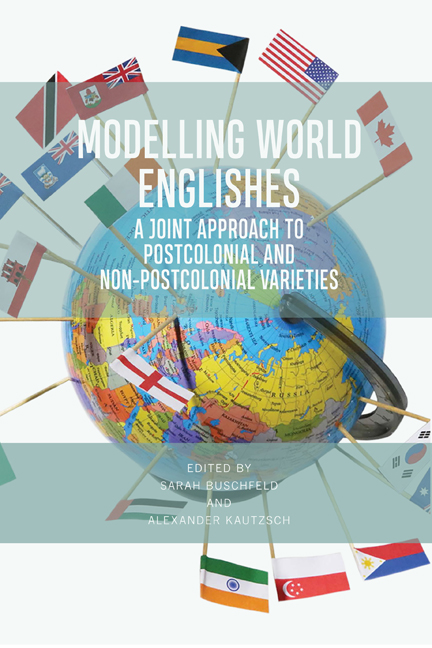Book contents
- Frontmatter
- Contents
- List of Figures and Tables
- List of Contributors
- Foreword
- 1 Introduction
- 2 English in England: The Parent Perspective
- 3 English in Namibia: Multilingualism and Ethnic Variation in the Extra- and Intra-territorial Forces Model
- 4 English in the United Arab Emirates: Status and Functions
- 5 English in India: Global Aspirations, Local Identities at the Grassroots
- 6 English in Singapore: Two Issues for the EIF Model
- 7 English in the Philippines: A Case of Rootedness and Routedness
- 8 English in South Korea: Applying the EIF Model
- 9 English in Japan: The Applicability of the EIF Model
- 10 English in Australia – Extra-territorial Influences
- 11 English in North America: Accounting for its Evolution
- 12 English in The Bahamas and Developmental Models of World Englishes: A Critical Analysis
- 13 Standard English in Trinidad: Multinormativity, Translocality, and Implications for the Dynamic Model and the EIF Model
- 14 Englishes in Tristan da Cunha, St Helena, Bermuda and the Falkland Islands: PCE, non-PCE or both? Blurred Boundaries in the Atlantic
- 15 English in Ireland: Intra-territorial Perspectives on Language Contact
- 16 English in Gibraltar: Applying the EIF Model to English in Non-Postcolonial Overseas Territories
- 17 English in Ghana: Extra- and Intra-territorial Forces in a Developmental Perspective
- 18 Synopsis: Fine-tuning the EIF Model
- Index
9 - English in Japan: The Applicability of the EIF Model
Published online by Cambridge University Press: 24 September 2020
- Frontmatter
- Contents
- List of Figures and Tables
- List of Contributors
- Foreword
- 1 Introduction
- 2 English in England: The Parent Perspective
- 3 English in Namibia: Multilingualism and Ethnic Variation in the Extra- and Intra-territorial Forces Model
- 4 English in the United Arab Emirates: Status and Functions
- 5 English in India: Global Aspirations, Local Identities at the Grassroots
- 6 English in Singapore: Two Issues for the EIF Model
- 7 English in the Philippines: A Case of Rootedness and Routedness
- 8 English in South Korea: Applying the EIF Model
- 9 English in Japan: The Applicability of the EIF Model
- 10 English in Australia – Extra-territorial Influences
- 11 English in North America: Accounting for its Evolution
- 12 English in The Bahamas and Developmental Models of World Englishes: A Critical Analysis
- 13 Standard English in Trinidad: Multinormativity, Translocality, and Implications for the Dynamic Model and the EIF Model
- 14 Englishes in Tristan da Cunha, St Helena, Bermuda and the Falkland Islands: PCE, non-PCE or both? Blurred Boundaries in the Atlantic
- 15 English in Ireland: Intra-territorial Perspectives on Language Contact
- 16 English in Gibraltar: Applying the EIF Model to English in Non-Postcolonial Overseas Territories
- 17 English in Ghana: Extra- and Intra-territorial Forces in a Developmental Perspective
- 18 Synopsis: Fine-tuning the EIF Model
- Index
Summary
INTRODUCTION
Since its first configuration in the mid-1980s, the world Englishes (WE) paradigm (Kachru 1985) has been of significant use in helping scholars to understand the differences in English varieties viewed from a historico-political lens and has fostered an appreciation for the diversity and pluricentricity of English today. The paradigm was further strengthened by the work of Schneider (2007) which helped to account for the dynamic and ongoing process of varietal development and change. Yet these models have been called into question (e.g. Seidlhofer 2001; Bruthiaux 2003; D’Angelo 2008, 2013; Seargeant and Tagg 2011) for their perhaps excessive focus on describing varieties of English and their lack of accounting for the mushrooming use of English in non-postcolonial settings of the Expanding Circle. The EIF Model, as proposed by Buschfeld and Kautzsch (2017), addresses these concerns and can make an important contribution by providing new ways of looking at varieties, while at the same time accounting for the complex use of English in the ever-shifting speech communities of the twentyfirst century. This chapter considers the case of Japan and its historical involvement with English from the point of earliest contact and analyzes the subsequent development of Japanese English to the present day. It presents a careful discussion of applying Buschfeld and Kautzsch’s EIF Model to Japan, both from the viewpoint of Schneider's original model, and the enhanced perspective offered by the EIF Model. Finally, the chapter investigates possible advantages of – and points that need further definition in – developing the EIF Model and its theoretical contribution to the field.
Issues with the Dynamic Model
Buschfeld and Kautzsch (this volume) thoroughly outline Schneider’s Dynamic Model (2003, 2007). This section highlights essential parameters of the model which are especially pertinent to our discussion of the Japan context and discusses issues with applying the Dynamic Model to non-PCE settings.
In the Dynamic Model, the analysis of each of the five phases (foundation through differentiation) is framed within four key parameters. These are: (1) extra-linguistic factors (e.g. the historical and political development of the country), (2) characteristic identity constructions (e.g. factors which change the population's concept of their own identity), (3) sociolinguistic determinants of the contact situation (e.g. conditions of language contact, language attitudes, and use), and (4) structural effects (e.g. the development of lexical, phonological, and grammatical characteristics).
- Type
- Chapter
- Information
- Modelling World EnglishesA Joint Approach to Postcolonial and Non-Postcolonial Varieties, pp. 179 - 201Publisher: Edinburgh University PressPrint publication year: 2020



